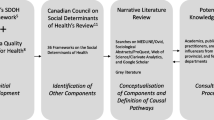Abstract
Introduction Existing health disparities frameworks do not adequately incorporate unique interacting contributing factors leading to health inequities among African Americans, resulting in public health stakeholders’ inability to translate these frameworks into practice. Methods We developed dimensionality and R4P to integrate multiple theoretical perspectives into a framework of action to eliminate health inequities experienced by African Americans. Results The dimensional framework incorporates Critical Race Theory and intersectionality, and includes dimensions of time—past, present and future. Dimensionality captures the complex linear and non-linear array of influences that cause health inequities, but these pathways do not lend themselves to approaches to developing empirically derived programs, policies and interventions to promote health equity. R4P provides a framework for addressing the scope of actions needed. The five components of R4P are (1) Remove, (2) Repair, (3) Remediate, (4) Restructure and (5) Provide. Conclusion R4P is designed to translate complex causality into a public health equity planning, assessment, evaluation and research tool.
Similar content being viewed by others
References
Bauer, G. R. (2014). Incorporating intersectionality theory into population health research methodology: Challenges and the potential to advance health equity. Social Science & Medicine, 110, 10–17.
Ben-Shlomo, Y., & Kuh, D. (2002). A life course approach to chronic disease epidemiology: Conceptual models, empirical challenges and interdisciplinary perspectives. International Journal of Epidemiology, 31, 285–293.
CDC. (1995a). Differences in maternal mortality among Black and White: United States. MMWR, 44(01):6–7, 13–14.
CDC. (1995b). U.S. infant and general mortality: Racial and socioeconomic disparities. NCHS press room. Retrieved February 16, 2015 from http://www.cdc.gov/nchs/pressroom/95facts/fsinfant.htm.
CDC. (1999). Achievements in public health, 1900–1999: Healthier mothers and babies. MMWR, 48(38):849–858.
Cole, E. R. (2009). Intersectionality and research in psychology. American Psychologist, 64(3), 170–180.
Collins, P. H. (2000). Black feminist thought. New York: Routledge.
Crenshaw, K. (1989). Demarginalizing the intersection of race and sex: Black feminist critique of antidiscrimination doctrine, feminist theory, and antiracist politics. The University of Chicago Legal Forum, 167, 139–167.
Duran, E. F., & Duran, B. M. (1995). Native American postcolonial psychology. New York: SUNY.
Earp, J., & Ennett, S. T. (1991). Conceptual models for health education research and practice. Health Education Research, 6(2), 163–171.
Ford, C. L., & Airhihenbuwa, C. O. (2010a). Critical race theory, race equity, and public health: Toward antiracism praxis. American Journal of Public Health, 100, S30–S35.
Ford, C. L., & Airhihenbuwa, C. O. (2010b). The public health critical race methodology: Praxis for antiracism research. Social Science & Medicine, 71(8), 1390–1398.
Gee, G. C., Walsemann, K. M., & Brondolo, E. (2012). A life course perspective on how racism may be related to health disparities. American Journal of Public Health, 102, 967–974.
Hankivsky, O. (2012). Women’s health, men’s health, and gender and health: Implications of intersectionality. Social Science & Medicine, 74, 1712–1720.
Harrell, S. P. (2000). A multidimensional conceptualization of racism-related stress: Implications for the well-being of people of color. American Journal of Orthopsychiatry, 70(1), 42–57.
Hertzman, C., & Boyce, T. (2010). How experience gets under the skin to create gradients in developmental health. Annual Review of Public Health, 31, 329–347.
Hogan, V. K., Rowley, D., Bennett, T., & Taylor, K. D. (2012). Life course, social determinants, and health inequities: Toward a national plan for achieving health equity for AA infants—A concept paper. Maternal and Child Health Journal, 16(6), 1143–1150.
Jones, C. P. (2001). Invited commentary: “Race,” racism, and the practice of epidemiology. American Journal of Epidemiology, 154(4), 299–304.
Jones, C. P., Jones, C. Y., Perry, G. S., et al. (2009). Addressing the social determinants of children’s health: A cliff analogy. Journal of Health Care for the Poor and Underserved, 20(suppl), 1–12.
Lu, M. C., & Halfon, N. (2003). Racial and ethnic disparities in birth outcomes: A lifecourse perspective. Maternal and Child Health Journal, 7(1), 13–30.
Michigan Department of Health and Human Services. (2015). Practices to reduce infant mortality through equity: A guide for public health professionals. Lansing, MI: Michigan Department of Health and Human Services; Bureau of Family, Maternal and Child Health. Retrieved September 6, 2017 from http://www.prime.mihealth.org/.
Muntaner, C. (1999). Invited commentary: Social mechanisms, race, and social epidemiology. American Journal of Epidemiology, 150(2), 121–128.
Powell, J. A. (2008). Structural racism: Building upon the Insights of John Calmore. North Carolina Law Review, 86, 791–816. Retrieved from http://www.prime.mihealth.org/
Schulz, A. J., & Mullings, L. (Eds.). (2005). Gender race, class and health: Intersectional approaches. San Francisco, CA: Jossey-Bass.
Solar, O., & Irwin, A. (2010) A conceptual framework for action on the social determinants of health. Social determinants of health discussion paper 2 (policy and practice). Retrieved March 1, 2014 from http://www.who.int/social_determinants/publications/9789241500852/en/.
Sotero, M. M. (2006). Conceptual model of historical trauma: Implications for public health practice and research. Journal of Health Disparities Research and Practice, 1(1), 93–108.
Tannahill, C., & Sridharan, S. (2013). Getting real about policy and practice needs: Evaluation as a bridge between the problem and solution space. Evaluation and Program Plannin, 36(1), 157–164.
Walters, K. L., & Simoni, J. M. (2002). Reconceptualing Native Women’s Health: An “indigenist” stress coping model. American Journal of Public Health, 92, 520–524.
Williams, D. R., Costa, M. V., Odunlami, A. O., & Mohammed, S. A. (2008). Moving upstream: How interventions that address the social determinants of health can improve health and reduce disparities. Journal of Public Health Management and Practice, 14(Suppl), S8–S17.
Yosso, T. J., Smith, W. A., Ceja, M., & Solorzano, D. J. (2009). Critical race theory, racial microaggressions, and campus racial climate for Latina/o undergraduates. Harvard Educational Review, 79(4), 659–690.
Funding
The funding was supported by WK Kellogg Foundation and Maternal and Child Health Bureau (Grant No. T03MC07643).
Author information
Authors and Affiliations
Corresponding author
Rights and permissions
About this article
Cite this article
Hogan, V., Rowley, D.L., White, S.B. et al. Dimensionality and R4P: A Health Equity Framework for Research Planning and Evaluation in African American Populations. Matern Child Health J 22, 147–153 (2018). https://doi.org/10.1007/s10995-017-2411-z
Published:
Issue Date:
DOI: https://doi.org/10.1007/s10995-017-2411-z




